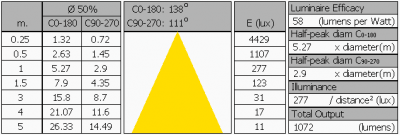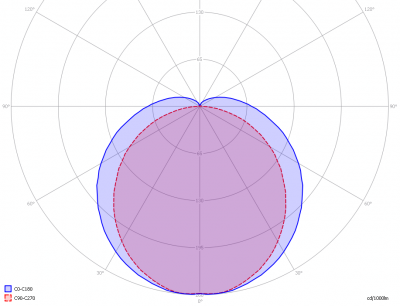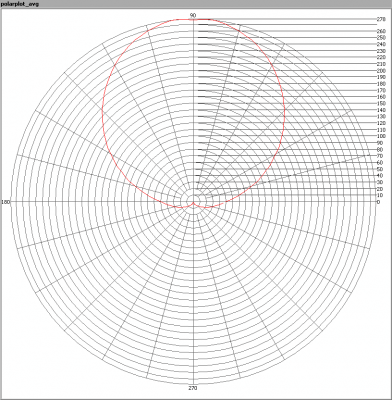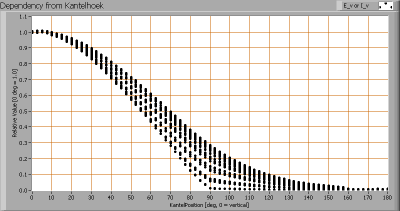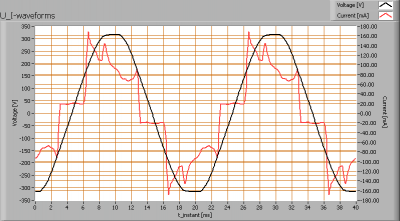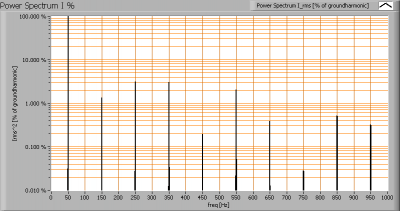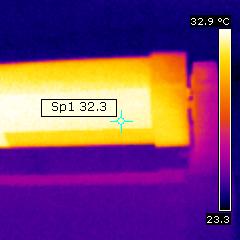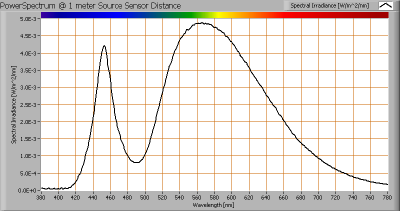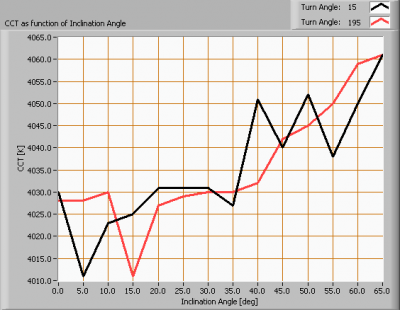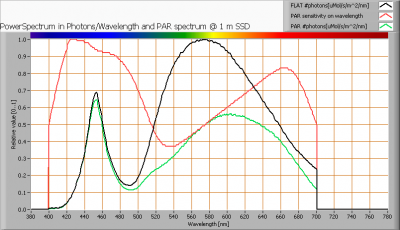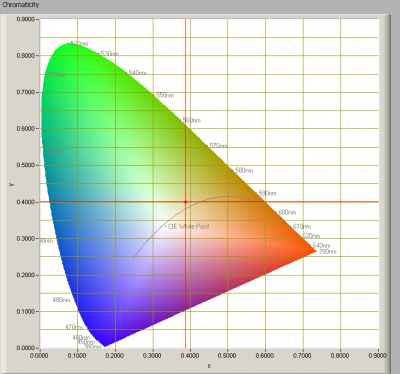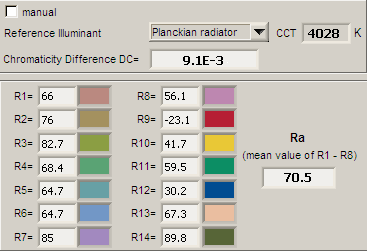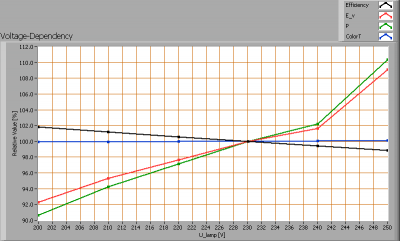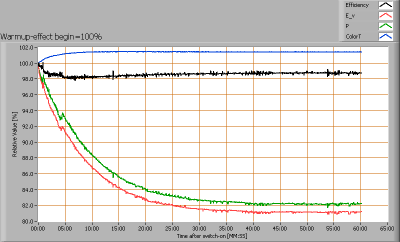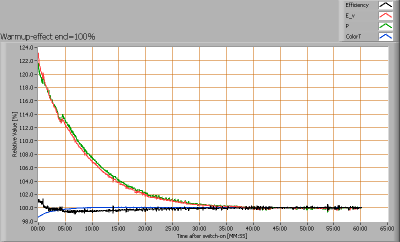Vermacom Lampyrida Matrix Neutral White
Posted by Marcel van der Steen in Led lights, Light measurements No Comments»![]() presents a 150 cm long LED tube light. The cover used is frosted, and was especially selected after a field test where a lot of people could give their preference. The color of the light is neutral white. Of the same model a warm white and cold white version are available.
presents a 150 cm long LED tube light. The cover used is frosted, and was especially selected after a field test where a lot of people could give their preference. The color of the light is neutral white. Of the same model a warm white and cold white version are available.
This article shows the measurement results. Many parameters are also found in the Eulumdat file.
See this overview for a comparison with other light bulbs.
Summary measurement data
| parameter | meas. result | remark |
|---|---|---|
| Color temperature | 4028 K | Neutral white |
| Luminous intensity Iv | 277 Cd | Measured straight underneath the lamp |
| Beam angle | 138 deg | 138º for the C0-C180 plane (crosses the length direction of tube), and 110º for C90-C270 plane (length direction of the tube). |
| Power P | 18.3 W | |
| Power Factor | 0.90 | For every 1 kWh net power consumed, there has been 0.5 kVAhr for reactive power. |
| Luminous flux | 1072 Lm | |
| Luminous efficacy | 58 Lm/W | |
| CRI_Ra | 70 | Color Rendering Index. |
| Coordinates chromaticity diagram | x=0.3859 and y=0.4003 | |
| Fitting | FL-tube | It is connected directly to the grid. |
| PAR-value | 2.3 μMol/s/m2 | The number of photons seen by an average plant when it is lit by the light of this light bulb. Value valid at 1 m distance from light bulb. |
| S/P ratio | 1.5 | This factor indicates the amount of times more efficient the light of this light bulb is perceived under scotopic circumstances (ow environmental light level). |
| D x L external dimensions | 29 x 1500 mm | External dimensions of the lamp. Excluding the pins. |
| L x W luminous area | 1474 x 29 mm | Dimensions of the luminous area (used in Eulumdat file). This is equal to the surface of the frosted cover. |
| General remarks | The ambient temperature during the whole set of measurements was 22-24 deg C. The lamp heats up only 10 degrees beyond ambient temperature.
Warm up effect: during the warm up time the illuminance decreases with ≈19 % and the consumed power with ≈18 %. Voltage dependency: the power consumption and illuminance do depend a little on the voltage when it is varied from 200 – 250 V. |
|
| Measurement report (PDF) | ||
| Eulumdat file |  |
Right click on icon and save the file. |
Overview table
The overview table is explained on the OliNo website. Please note that this overview table makes use of calculations, use this data with care as explained on the OliNo site.
Eulumdat light diagram
This light diagram below comes from the program Qlumedit, that extracts these diagrams from an Eulumdat file. It is explained on the OliNo site.
The light diagram giving the radiation pattern.
It indicates the luminous intensity around the light bulb. In the length direction (C90-C270) the beam angle is somewhat smaller than perpendicular on it (C0-C180).
Illuminance Ev at 1 m distance, or luminous intensity Iv
Herewith the plot of the averaged luminous intensity Iv as a function of the inclination angle with the light bulb.
The radiation pattern of the light bulb.
This radiation pattern is the average of the light output of the light diagram given earlier. Also, in this graph the luminous intensity is given in Cd.
These averaged values are used (later) to compute the lumen output.
Intensity data of every measured turn angle at each inclination angle.
This plot shows per inclination angle the intensity measurement results for each turn angle at that inclination angle. There normally are differences in illuminance values for different turn angles. However for further calculations the averaged values will be used.
When using the average values per inclination angle, the beam angle can be computed, being 110º for C90-C270 plane (length direction) and 138º for the C0-C180 plane (crossing the length direction).
Luminous flux
With the averaged illuminance data at 1 m distance, taken from the graph showing the averaged radiation pattern, it is possible to compute the luminous flux.
The result of this computation for this light spot is a luminous flux of 1072 Lm.
Luminous efficacy
The luminous flux being 1072 Lm, and the power of the light bulb being 18.3 W, yields a luminous efficacy of 58 Lm/W.
A power factor of 0.90 means that for every 1 kWh net power consumed, a reactive component of 0.5 kVAr was needed.
| Light bulb voltage (used on power supply!) | 230 VAC |
| Light bulb current | 88 mA |
| Power P | 18.3 W |
| Apparent power S | 20.3 VA |
| Power factor | 0.90 |
Of this light bulb the voltage across ad the resulting current through it+its constant current driver power supply are measured and graphed. See the OliNo site how this is obtained.
Voltage across and current through the lightbulb
The current does not look like a sine, but it tries to approach it. There are peaks (steep edges) in the current form, which will lead to higher harmonics. The current phase is leading a little bit the voltage. The result is a nice powerfactor of around 0.9.
Also the power spectrum of the current is determined.
Current power spectrum in % of the first harmonic (50 Hz).
Due to the steep edges in the current there are some higher harmonics in the current spectrum.
Temperature measurements lamp
Temperature measurement after warm up
| status lamp | > 2 hours after switch on |
| ambient temperature | 22 ºC |
| camera | Flir B-CAM Western S |
| emissivity | 1.00(1) |
| measurement distance | 0.4 m |
| IFOVgeometric | 1.5 mm |
| NETD (thermal sensitivity) | 100 mK |
(1) The emissivity is set such that the temperature reading with the IR camera corresponds to the temperature reported by a contact measurement..
The lamp gets wamr-to-the-touch which is quite cool, and the heat seems evenly distributed.
Color temperature and Spectral power distribution
The spectral power distribution of this light bulb, energies on y-axis valid at 1 m distance.
The measured color temperature is about 4025 K which is neutral white.
This color temperature is measured straight underneath the light bulb. Below a graph showing the color temperature for different inclination angles.
Color temperature as a function of inclination angle.
The measurement of CCT has been stopped when the inclination angle was 65 as the illuminance value was decreased to very low values there (< 5 lux).
The beam angle is 138º, meaning an inclination angle of max 69º. Almost all light falls within this angle. The variation of the color temperature within this angle is about 1 %.
PAR value and PAR spectrum
To make a statement how well the light of this light bulb is for growing plants, the PAR-area needs to be determined. See the OliNo website how this all is determined and the explanation of the graph.
The photon spectrum, then the sensitivity curve and as result the final PAR spectrum of the light of this light bulb
The PAR number for this light results in 2.3 μMol/s/m2. This value is valid at 1 m distance from the light bulb and valid roughly inside its beam angle.
The PAR efficiency is 63 % (valid for the PAR wave length range of 400 – 725 nm). So maximally 63 % of the total of photons in the light is effectively used by the average plant (since the plant might not take 100 % of the photons at the frequency where its relative sensitivity is 100 %).
S/P ratio
The S/P ratio and measurement is explained on the OliNo website. Here the results are given.
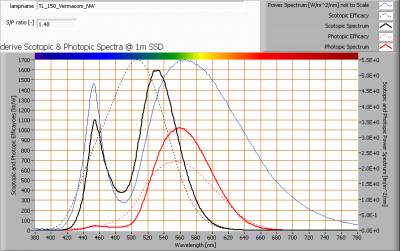
The power spectrum, sensitivity curves and resulting scotopic and photopic spectra (spectra energy content defined at 1 m distance).
The S/P ratio is 1.5.
More info will come in a separate article.
Chromaticity diagram
The chromaticity space and the position of the lamp’s color coordinates in it.
The light coming from this lamp is at a distance from the Planckian Locus (the black path in the graph).
Its coordinates are x=0.3859 and y=0.4003.
Color Rendering Index (CRI) or also Ra
Herewith the image showing the CRI as well as how well different colors are represented (rendered). The higher the number, the better the resemblance with the color when a black body radiator would have been used (the sun, or an incandescent lamp).
Each color has an index Rx, and the first 8 indexes (R1 .. R8) are averaged to compute the Ra which is equivalent to the CRI.
CRI of the light of this lightbulb.
The value of 71 is smaller than 80 which is considered a minimum value for indoor usage.
Note: the chromaticity difference is 0.0091 indicates the distance to the Planckian Locus. Its value is higher than 0.0054, which means that the calculated CRI result is not meaningful.
Voltage dependency
The dependency of a number of lamp parameters on the lamp voltage is determined. For this, the lamp voltage has been varied and its effect on the following light bulb parameters measured: illuminance E_v [lx], the lamppower P [W], the (Correlated) Color Temperature [K] and the luminous efficacy [Lm/W].
Lamp voltage dependencies of certain light bulb parameters, where the value at 230 V is taken as 100 %.
The illuminance and consumed power vary a bit when the voltage is varied.
When the voltage at 230 V varies with + and – 5 V, then the illuminance varies ≈ 1.0 %, so when abrupt voltage changes occur this effect is not visible in the illuminance output.
Warm up effects
After switch on of a cold lamp, the effect of heating up of the lamp is measured on illuminance E_v [lx], color temperature CT or correlated color temperature CCT [K], the lamppower P [W] and the luminous efficacy [lm/W].
Effect of warming up on different light bulb parameters. At top the 100 % level is put at begin, and at bottom at the end.
The warm up time is about 30 minutes. During that time the illuminance decreases with ≈19 % and the consumed power with ≈18 %.
